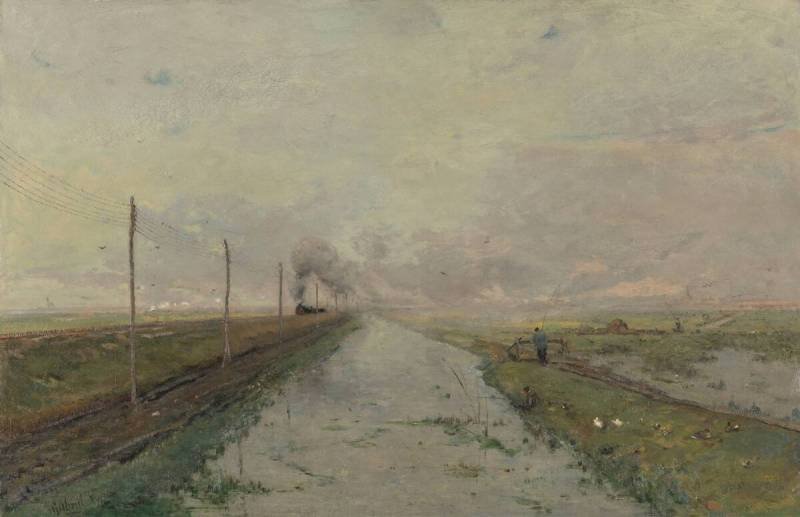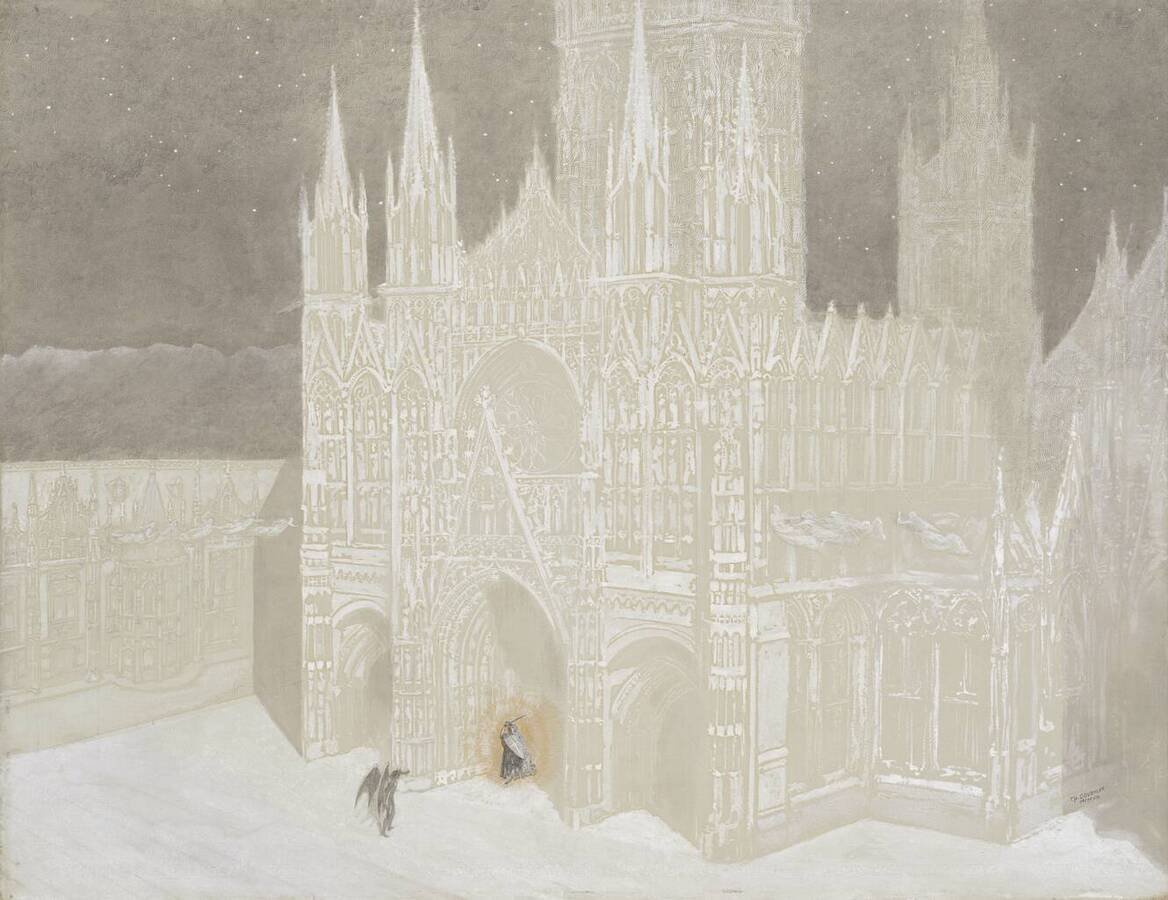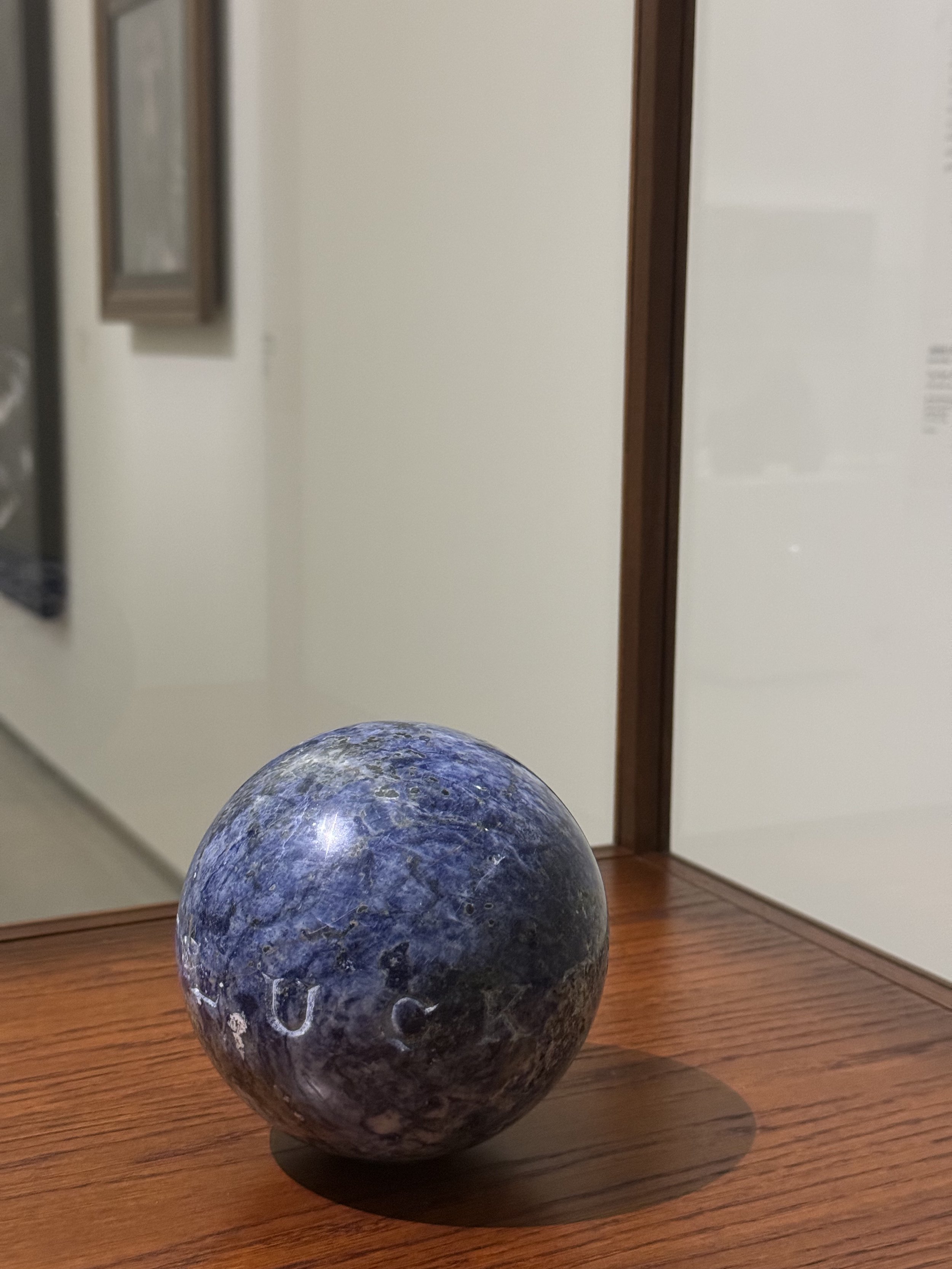The active presence of invisible forces
a review of the exhibition Searching for Meaning
Diana Murray Watts
In the turbulence of our days and the hope of an imagined future we find ourselves. This is not too distant from the world of Helene Kröller-Müller (1869 – 1939) who, upon encountering the literature of German philosophers and writers such as Lessing, Goethe, and Schiller, began to question her faith.
The exhibition Searching for Meaning can be better understood from the perspective of Helene’s life and work. The following pages will aim at unveiling those episodes in the life of Helene Kröller-Müller that help to illustrate the relationship between spirituality and philosophy as one of the main foundations upon which the museum’s collection is built.
Born and raised in Germany, she was the third child of Emilie Neese and the wealthy industrialist Wilhelm Müller. The iron ore and coal company that Mr. Müller established with Hugo Neese, his brother-in-law, would lead the family to enjoy an ample financial success.
In her childhood, Helene barely came into contact with the arts for the simple reason that her family was not interested in them. She did, however, became acquainted with the ideas of the Enlightenment and came to appreciate, above all, the ideas of Spinoza. His views urged liberation. Years later, the studious and curious Helene would spring from this platform of inspiration with her own motto: ‘Spiritus et Materia’ – spirit and matter are one. Indeed, a plaque boasting this motto can still be admired on one the main façades of the Kröller-Müller Museum today. Designed by Belgian artist and architect Henry van de Velde, it testifies to the spirit that Helene Kröller-Müller imbued into this modern and contemporary art museum in Otterloo, The Netherlands.
Dutchman Anton Kröller came to work at her father’s company in 1883. Five years later, Helene married him and gave him a family of four children. The Wm H. Müller & Co. continued to grow and became a highly profitable international ore and shipping company. In 1900, it was decided that the company headquarters move to The Hague. Helene was 36 years-old when, together with her daughter, began to take art appreciation classes from the art educator H.P. Bremmer. He introduced them to modern art and, more particularly for Helene, to the personal, deeply spiritual experience that art can be. Under this influence, Helene Kröller-Müller began to collect art. It comes from afar (c. 1887), an idyllic Dutch polder landscape by Paul Gabriël, became her first acquisition. Rather unsurprisingly, Helene named Bremmer as her personal advisor to assist her in the pursuit of assembling an art collection. Bremmer himself had broken with the church as a young man and found in Spinozism the answers that he longed for, most notably the encounter with the realm of the soul through art.
Paul Joseph Constantin Gabriël, It comes from afar, ca. 1887, oil on canvas, 67 x 100 cm.
Copyright Kröller-Müller Museum.
Vincent Van Gogh, Basket of Lemons and Bottle, 1888, oil on canvas, 53,9 x 64,3 cm.
Copyright Kröller-Müller Museum.
Bremmer was a great admirer of the then lesser-known Vincent van Gogh. Under his advice and expertise, Helene purchased, in 1908, her first paintings by this Dutch artist: Edge of a wood (1883) and Four sunflowers gone to seed (1887). Just a year later, she acquired Van Gogh’s The Sower (after Millet) (1890) and Basket of lemons and bottle (1888), an oil on canvas that adorns the main entrance to the exhibition Searching for Meaning, with one of Helen’s written reflections above it: “If you can place yourself in the mind of someone who was able to see lemons and interpret them for us in such a way, then you will enjoy art because from it you feel that, despite everything, there is something in the world that we are always seeking and for which we should always have respect.” (March 1909) Much in the spirit of Spinoza, one can begin to discern an inquisitive personality that seeks for an intimate relationship with art and unity with the world.
In 1911, Helene received the announcement that she will have to undergo a life-threatening operation. This marking news led her to, rather resolutely, declare her wish to build a museum house for her collection and to bequeath it to the Dutch people. A “monument to culture”, she would describe it in a letter to her close friend Sam van Deventer. History wants it that Helene survives the operation. Determined to realize her plan, Museum Kröller – the precursor to today’s Kröller-Müller Museum – opened in 1913 on Lange Voorhout in The Hague. Its spacious walls allowed Helene to make room for works by Old Masters displayed alongside her selections of Modern art. Moreover, the search for God in all that is earthly, located at the core of Spinoza’s teachings, would, under Helene’s leadership, deeply infuse into the museum’s foundations.
Amidst rising financial difficulties at the family company, Helene decided to protect her collection through the creation of the Kröller-Müller Foundation. On 26 April 1935, she used it to donate the entirety of her collection to the Dutch State under the promise to house it in a new museum on the Hoge Veluwe. That same day, the De Hoge Veluwe National Park Foundation saw its birth with the mission to become both a national park and a cultural center. The official opening of the Kröller-Müller Museum was recorded on 13 July 1938. Helene, however, would only briefly enjoy her museum. Aged 69 with heavily deteriorated health, she passed away the following year on 14 December. Her corpse would be laid out amid her beloved Van Goghs, directly in front of Four sunflowers gone to seed.
Image 1. Vincent Van Gogh, Four Sunflowers Gone to Seed, 1887, oil on canvas, 59,5 x 99,5 cm.
Copyright Kröller-Müller Museum.
Image 2. The corpse of Helene Kröller-Müller is laid out in her museum. Copyright Kröller-Müller Museum.
Searching for Meaning features the works of artists for whom Helene felt a great admiration. Indeed, she noticed that their soul ‘was too strongly expressed in them’ through their inclination towards philosophy and spirituality. The exhibition also displays works that were acquired by successive museum directors who followed in the same vein as Helene’s.
Helene was particularly fond of Renaissance art. Italian paintings, however, were rather unaffordable for her at that time, and so she mainly acquired works on paper. A personal favorite, The Risen Christ between St. Andrew and St. Longinus (ca. 1472) by Andrea Mantegna, hung above her writing desk and is on display in the exhibition.
Andrea Mantegna, The Risen Christ between St. Andrew and St. Longinus, c. 1472, engraving, pen and black ink, brush and watercolor on paper, 31,7 x 28 cm. Photo taken at the exhibition.
The larger-than-life sculptural work in painted apple wood by Ossip Zadkine helps to frame the exhibition title on the wall. The sculpture titled Rebecca (1927) was first given a permanent place in the Kröller-Müller Museum’s own sculpture gallery that was completed in 1953. It shows how its then director, Bram Hammacher, was careful in selecting art with a spiritual or philosophical slant; just as Helene would have liked. The sculpture is a direct reference to the passage in the Old Testament in which Abraham’s servant chooses Rebecca as her master’s future wife after she generously gives water to him and all his camels.
Ossip Zadkine, Rebecca, 1927, painted apple wood, 260 x 80 x 80. Photos taken at the exhibition.
Bart van der Leck, Mother and Child, 1921, oil on canvas, 80 x 62,5 cm. Photo taken at the exhibition.
Nearby, still in the same room, Mother and Child (1921) by Bart van der Leck creates an indelible impression. A full abstraction from a pictural perspective, it surprises the viewer with its precision to create, with an altogether ingenuity, an altar-like work featuring just those two characters.
One of the founders of the artist group Les Nabis (Hebrew for ‘the prophets’) was Maurice Denis. The work on display by this French artist is Roman Catholic Mystery (1891), a delicate oil on canvas with a pointillist technique, is an Annunciation scene that replaces the angel Gabriel by a deacon and choirboys. A view of the French countryside can be clearly seen through the window. As young artists who sought ‘beauty beyond the visible reality’, it is not surprising why Helene would have expressed interest in acquiring this painting by a member of Les Nabis. Moving through the room, and following one’s gaze toward the right, Death at the Ball (ca. 1865-1875) by Félicien Rops contrasts sharply with the peace and quiet easily felt by other paintings nearby. A rather somber subject matter as it portrays death itself at an imaginary ball. Painterly, it oozes with richness for the ingenious interplay between the black background and the figure of death in the foreground whose gown is lit just enough for the viewer to summon it from the surrounding darkness.
Reflections on life and death were certainly at the epicenter of Helene’s thought process. Her interest in the work by Odilon Redon, therefore, can be understood from this very perspective. There are three works of him in the exhibition, hung on the same large wall. The Sacred Heart (The Buddha) (ca. 1906) is particularly intriguing as it fuses Jesus and Buddha into a single human-like figure. The result is an implosion of color expressed in pastel and charcoal on paper that succeeds at depicting the calmness and sanctity of both spiritual leaders. It is unclear as to what the figure carries – if any – on its hands. A ball of light seems to emanate from the surface of the paper, presenting streaks that create a somewhat aural movement near the bottom of the canvas. Redon believed that uniting religions was an important task for art. The viewer might feel as if he is witnessing the birth of a dream or the making of a cosmic change.
Odilon Redon, The Sacred Heart (The Buddha), ca. 1906, pastel and charcoal on paper, 65,4 x 50,1 cm.
Photos taken at the exhibition.
Belgian artist Xavier Mellery succeeds at transmitting the sheer coldness of a deep winter day. His Wintry Day (date unknown) was purchased just a couple of years after Helene Kröller-Müller’s death. It may so be that her successor as museum director Sam van Deventer, with whom during many years Helene had addressed an intimate correspondence, rather understandably still felt the sadness of her absence weighting upon him. The composition features a single human figure, standing motionless next to the side façade of what one can suspect is a peasant’s home. The light seems to announce the imminence of dusk and the solace of the leafless trees complements the figure barely discernible under a long, black cloak. More so than a winter scene, Mellery paints solitude.
Xavier Mellery, Wintry Day, date unknown, oil on canvas, 67,5 x 53,7 cm. Photos taken at the exhibition.
I am also stricken by three oils on canvas by Piet Mondrian. Farm at Duivendrecht, in the Evening (ca. 1916) contrasting with Composition 10 in Black and White (1915), and itself resonating with Composition with Red, Yellow and Blue (1927). The first painting goes beyond the mere representation of a landscape into the depiction of another single, all-encompassing element: the evening. Indeed, Mondrian skillfully plays with the physical limits of the canvas to build a scene inundated by both the dimming light and rising darkness of dusk. The houses, the trees and the lake are therefore nothing but accessories in the depiction of this battle between the parting day and the arriving night. The painting vibrates with intensity amidst the apparent calm that this outdoor scene. The latter two works by Mondrian are not far from another type of spirituality. At first, the Dutch painter sought this condition through his landscapes. Eventually, however, he would come to believe that abstract art could provide a spiritual experience through its very own interplay of rhythm and proportions brought by lines, colors, and shapes. The exhibition label dedicated to Mondrian explains that his aim was to deconstruct the natural world and reconstruct it according to the spirit to ‘make the beauty of life visual, tangible and perceptible’. Bremmer purchased Composition 10 in Black and White, for Helene, on 3 October 1915. Her eye had been beautifully trained as only ten years ago she had begun her art appreciation lessons under his leadership. It is therefore not surprising that a private cabin was specially constructed inside the exhibition as a tasteful means to display this painting. The viewer is lured to seat on a wooden bench – also built for the occasion – and admire the canvas with nothing else obstructing his eyes. I lost track of the long moment spent gazing through this work, feeling joy at having both my eyes and thoughts get lost inside the geometrical intricacies of this monochrome composition.
Fig. 1 and 2: Curatorial display featuring an intimate setting for the viewer to take a moment with Piet Mondrian, Composition 10 in Black and White, 1915, oil on canvas, 85,8 x 108,4 cm. Photos taken at the exhibition.
Fig. 3 and 4: Piet Mondrian, Composition 10 in Black and White, 1915, oil on canvas, 85,8 x 108,4 cm. Photos taken at the exhibition.
Searching for Meaning also breathes space for two equally intriguing works by Jan Toorop. The first composition one encounters when following the suggested exhibition path is Organ Sounds, July-August (1891). It is a chalk and pencil on cardboard that crates a lady-like figure out of pure contouring motions on the far right. The far left is adorned by the view of a city skyline at dusk, itself framed by a large window in the room that accommodates this mysterious female enraptured by the music she is playing with the organ’s keys. There is something starkly morose about this work, let alone the skulls that lie on the city’s grounds as if forming a cemetery arrangement. Is the lady’s musical feat meant to support the incantation of unearthly creatures? Art historian Denis Laoureux explains in the exhibition catalogue Charles Doudelet et le symbolisme – Les Portes d’or, that “to make supra-sensible realities enter the material limits of a canvas implies, from the part of painters, that they provide themselves with specific plastic means.”[1] Speaking of Symbolist painters, Laoureux goes on to enlist those elements in such a visual composition: “The tonal muting, the monochrome character of the palette, the sense of purity in the composition, the complexity in the arrangement of interior spaces, the evaporation of contours evoking the influence of memory, the strange lights, the plasticity of the void are the visual parameters that suggest the active presence of invisible forces.”[2] This novel approach also takes over the second work by Toorop on display. Les rôdeurs (1892) is an impressive use of ink, chalk, pastel and pencil to create an unworldly scene of sorrows. It is the Dutch painter’s own version of the Fall of Man. Almost at the center of the composition lays the body of a young woman, symbol of virginal innocence. Her aggressive assailers are men who have been overcome by the call of sensuality. Indeed, all the men look as if possessed by a force much stronger than their own will. Perhaps the only figure in full presence is that of the woman standing behind the laying girl. With her right hand placed above her chest and her sincere, protruding eyes, she is either about to begin or has just finished a prayer from her tiny, yellow-paged book. And yet, there seems to be no escape.
Jan Toorop, Les rôdeurs, 1892, ink, chalk, pastel and pencil on cardboard, 65 x 76 cm.
Copyright Kröller-Müller Museum.
The Defense of the Ideal (1908) was purchased early during Helene’s lifetime. Featuring ink, gold paint and watercolor on paper, it contrasts greatly with Toorop’s earlier depiction of human frailty. Belgian artist Charles Doudelet goes on to create another unworldly scene. This time, however, it implies the capacity of the human heart to drive away evil. One must look rather closely to discern the only two figures in the composition: a sword-swaying knight at the main entrance of a Gothic church and a winged devil only wishing that he could come in. “Like many artists of this period, Doudelet is interested in the invisible forces that stir the world. Death, fatality, love, silence, survival of consciousness are themes that he explores. It is for this reason that he is interested in the symbol of the door. Indeed, the door is an iconographic detail central to end-of-century visual and literary culture. It represents a passage between two worlds, as demonstrated by his drawing and poem Les Portes d’or,”[3] explains Laoureux. In 19th-century Belgium, the past was a fertile ground for artists to seek for their roots. Doudelet himself blends two ancient visual cultures: the late Flemish Gothic painting and the Italian Renaissance. Moreover, The Defense of the Ideal inscribes itself with Helene’s lifelong search for the highest truths. A deep follower of Spinoza, she would have agreed with his Ethics, a text whose aim was to show that a life in which reason reveals the true nature of things is exactly the best life one can live.[4] Understanding the nature of things, implied Spinoza, would liberate us from the bondage of false beliefs and futile passions. Could this be what the knight in the artwork was defending himself against?
Charles Doudelet, The Defense of the Ideal, 1908, ink and paint (gold paint and watercolor) on paper, 48 x 62,2 cm. Copyright Kröller-Müller Museum.
James Lee Byars, The Path of Luck, 1992, Granite (African blue), diameter of 12,5 cm.
Photo taken at the exhibition.
After such painstaking visual travels into the painterly worlds of many artists that were dear to Helene Kröller-Müller and her successors, it is a 21st-century artwork that, to me, coronates Searching for Meaning. Inconspicuously on display inside a carefully constructed wood and glass pedestal, The Path of Luck (1992) by James Lee Byars gleefully sits in balance. At a distance, it stands as a well-polished sphere of granite. From up close, however, it invites the careful reading of its inscription, engraved exactly on the sphere’s centerline: the path of luck. It is a direct reference to Buddha’s concept of the path that he believed would lead to happiness and spiritual freedom. The piece was acquired by Lisette Pelsers, director from 2012 to 2023. It speaks of the coming together of East and West as in both spiritual traditions the sphere is a symbol of infinity, perfection and purity. Moreover, blue has been agreed upon as the color of the celestial and the divine. Would Helene have agreed on this acquisition for her beloved collection? A plausible answer could lie in the aura of a reflection by Charles Doudelet: “We must remember that the artist, in his soul, forms for himself a separate world, a personal vision of men and things; everyone other than him effortlessly perceives the superficial appearance of his dream.”[5] And yet, dreams were nothing superficial for Helene.
The exhibition Searching for Meaning is on view until 11 May 2025 at the Kröller-Müller Museum.
Diana Murray Watts is a writer, curator, and art advisor. She is currently pursuing a PhD in Philosophy, Art and Social Thought at The European Graduate School.
View of one of the main façades of the Kröller-Müller Museum, featuring the exhibition poster on the right and Helene Kröller-Müller’s emblem, designed by Henry Van de Velde between 1937-1938, for her motto ‘Spiritus et Materia’. Photo taken upon departure.
[1] Laoureux, Denis. Charles Doudelet dans le symbolisme belge. Essay in the exhibition catalogue Charles Doudelet et le symbolisme – Les Portes d’or. Silvana Editoriale, Milan. 2022. p. 31
[2] Ibid.
[3] Laoureux, Denis. L’avant-propos du commissaire. Interview in the exhibition catalogue Charles Doudelet et le symbolisme – Les Portes d’or. Silvana Editoriale, Milan. 2022. p. 11
[4] Grayling, A.C. The History of Philosophy. Penguin Books, Great Britain. 2020. p. 212
[5] Doudelet, Charles. Le symbolisme dans la peinture. Excerpts in the exhibition catalogue Charles Doudelet et le symbolisme – Les Portes d’or. Silvana Editoriale, Milan. 2022. p. 14





















